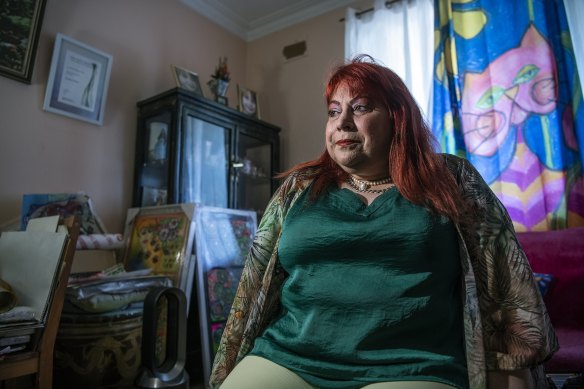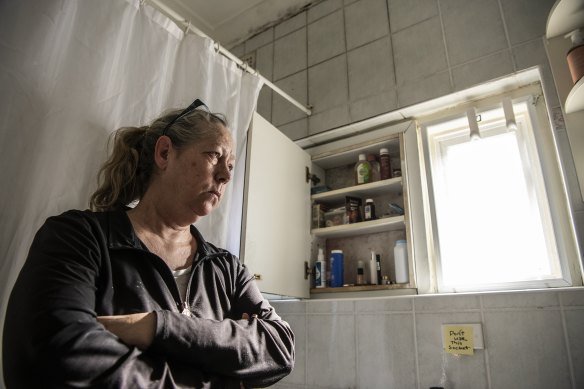This was published 1 year ago
Mushrooms on the wall, ruined clothes, brain fog: The Sydney tenants living with mould
Mould has always been an issue for Nada Suzal’s apartment, but four years ago, it turned catastrophic.
The toxic fungi crept up the walls of her public housing unit in Waverley and grew in spatters across her roof. It lined her bathroom window and took over her wardrobe, ruining her clothes. Mushrooms sprouted from the walls.

It took years for the government to address chronic mould in Nada Suzdal’s public housing unit, and now the mould is returning.
Suzal resorted to sleeping on her couch as mould enveloped her bedding.
Despite photos showing just how severe and chronic the problem was, requests for maintenance from her landlord – the NSW Land and Housing Corporation – were denied.
Last year her NDIS-funded cleaner quit due to health concerns.
The NSW government owns and manages nearly 100,000 public housing units. LHC has responded to nearly 300 public housing mould complaints in the past four months, and 1153 in the previous financial year.
Redfern Legal Centre Tenants’ Advocate Alison Mackey said the mould was a “chronic issue” affecting tenants across the city, with humidity in summer exacerbating issues.
“It’s really difficult for public housing tenants to get mould issues rectified simply by raising it with their landlord [the LHC],” she said.
Two doctors have written letters stating that Suzal, 62, now suffers from wheezing and has a reduced lung capacity due to the mould, while Suzal said she suffers from brain fog.
“I can’t go to the gym anymore. I’m hopeless now. It’s like I’m 100 years old, I can’t walk up the road without huffing and puffing,” she said. “My quality of life is really poor now.”
Her neighbours, Angela Sharp and Perry Bonassi, have also reported mould damage and requested repairs.
Sharp, who has an acute, chesty cough, holds her breath in the bathroom and keeps the door shut.
“I don’t have a chance to wash my hair and have a proper cleanse because all I want to do is get out of the bathroom ... I’m worried about the steam and spores,” Sharp said.
Bonassi washes his walls with bleach every week and sleeps on his couch.

Angela Sharp holds her breath when using her bathroom at her public housing unit in Waverly to avoid breathing in mould spores.
With the help of a support worker from Anglicare and a tenant’s advocate, Suzal brought her case to the NSW Civil and Administrative Tribunal earlier this year.
She received a year’s worth of reduced rent, compensation for her damaged property and her walls were scrubbed and repainted. Public housing tenants pay 25-30 per cent of their income in rent.
But she is worried the fix isn’t permanent: The paint in her bath is cracking with mould forming underneath, and her lungs have not recovered.
Eastern Area Tenants’ Service tenant advocate Phoenix Van Dyke, who represented Suzal at the tribunal, questioned how much the government would be spending on reduced rent and compensation for these mould cases instead of addressing the root causes.
“They’re paying this compensation, but not actually fixing the crux of the problems,” she said.
Mackey said tenants were often forced to provide evidence the mould was caused by a structural issue – and not a lack of maintenance – in order for a landlord to be held responsible.
“Our view … is that mould is a chronic issue that results in significant health concerns, so landlords should be responsible for rectification regardless of its cause,” Mackey said.
Homelessness NSW acting CEO Amy Hains said much of the state’s social housing stock needed retrofitting to make it liveable.
“People should not be forced to choose between mouldy and poorly ventilated accommodation, and sleeping in their cars or on the street. Mould can pose serious health issues to residents, and the state has a duty of care to provide social housing that is safe to inhabit,” she said.
Minister for Housing and Homelessness Rose Jackson said the Waverly property stories were “deeply disappointing” and represented “unacceptable living conditions”, and has requested the matter be investigated by the department.
“We can absolutely do more to lift living standards for all tenants and as the minister for housing and homelessness, this will always be a priority for me,” she said.
$35 million was announced as part of the Essential Housing Package in the latest state budget to support critical maintenance for social housing. But Jackson acknowledged more needed to be done.
“We know this initial funding won’t solve this crisis overnight ... Everyone deserves to live in a safe and secure home,” she said.
Start the day with a summary of the day’s most important and interesting stories, analysis and insights. Sign up for our Morning Edition newsletter.